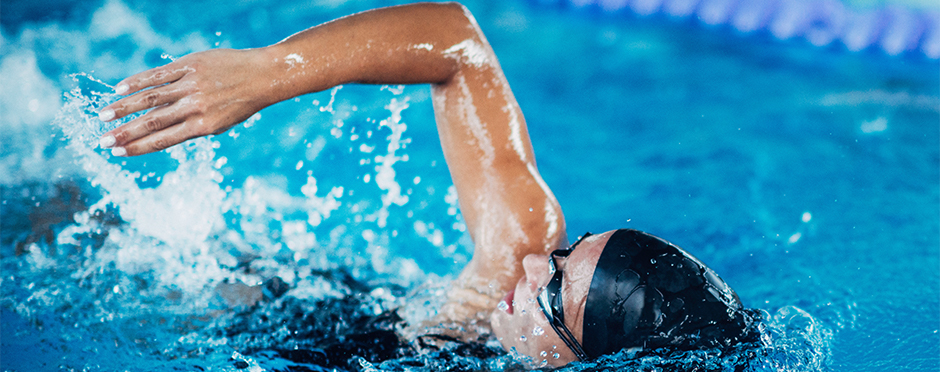
What is Swimmer’s Shoulder?
Leave a CommentSwimming – whether for recreation, for exercise, or as part of an organized team – is well known as a low impact, excellent source of activity. While swimming has many benefits for both cardiovascular health and strengthening of multiple muscle groups, it is not without risks.
Swimmer’s shoulder is a common condition for swimmers, with symptoms presenting as pain in the shoulder, occasionally down into the biceps. Swimmer’s shoulder can occur at any point throughout the lifespan, and for competitive to hobby swimmers. While research regarding risk for swimmer’s shoulder is still developing, a combination of prolonged exposure, weak shoulder/scapular/core muscles, poor stroke mechanics, and tight pectoral muscles are thought to contribute to the condition.
Preventing Swimmer’s Shoulder
In the Pool
- Alternate strokes – Alternating the strokes you swim helps to utilize different muscle groups, allows for balanced strengthening and avoids prolonged stress on any one part of the body.
- Mechanics – The average swimmer performs thousands of strokes a week, meaning thousands of shoulder revolutions! Therefore, non-optimal mechanics can have a huge impact. Work with a swim coach or your physical or occupational therapist to assess your own swim mechanics so you can improve your form. Keep in mind that form isn’t only important while swimming, ensure that you focus on upper body positioning with any kicking drills in the pool, as this can be a lengthy source of poor positioning for some swimmers.
- Rest – It is important to allow your body time to rest and recover. Doctors recommend taking 1-2 days off from swimming a week to prevent overuse injuries.1 Similarly, if you are starting to notice pain, that is your body telling you that it needs a rest. Listen to your body and do not swim through pain. If pain continues for more than 48 hours, contact a medical professional for assessment.
- Breathing – There is evidence suggesting that breathing patterns while swimming may affect shoulder pain. Swimmers who only breathe on one side instead of alternating are at a higher risk for overuse injuries.3
Out of the Pool
- Land training – Cross training, participating in sports or exercises other than swimming, is an excellent way to minimize the risk of swimmer’s shoulder. Cross training on land can help to maintain conditioning, endurance and abdominal/trunk strength without requiring a heavy load on the shoulders. Ensure that you work with a medical professional to ensure you are beginning a safe cross-training program.
- Core strengthening – maintaining a strong core can help to provide a strong base of support for your shoulders, reducing the risk of overuse. There are many ways to strengthen your core, see below for one example:
- Leg lifts: lay on your back, with your legs straight out. Tightening your abdominals, raise your legs up as high as you are able to while maintaining your low back flat on the ground and avoiding any pain. Slowly lower back down to the ground, repeat 20x.
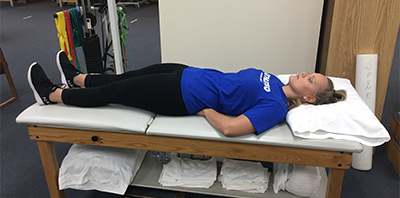
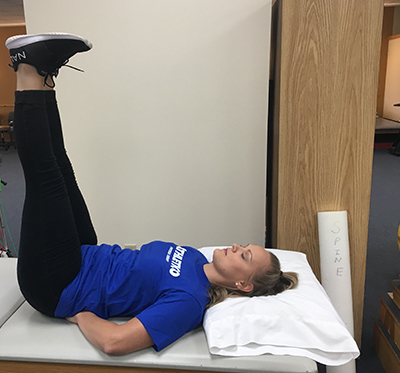
- Pec stretching – swimmers often have tight pectoral muscles, which can contribute to sub-optimal shoulder positioning. Working pec stretches, after appropriately warming up, into your routine can help reduce your chance of injury. See below for an example:
- Lie on your back with a half foam roller or rolled up blanket down your spine. Lay your arms out to either side of you with your elbows bent and palms facing up until you feel a gentle stretch across your chest. This exercise should not produce any pain.
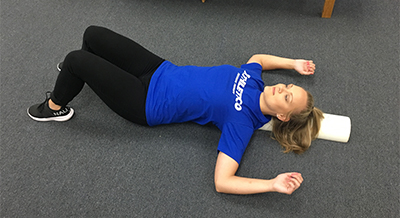
- Scapular muscle strengthening – strong, stable scapular stabilizer muscles can help to prevent shoulder and rotator cuff overuse. Keeping your middle trap and lower trap strong can help reduce the risk of injury.
- Mid trap: Lie with your stomach/chest over a large exercise ball facing the ground. Start with your arms hanging down toward the ground, then, leading with your thumbs, bring your arms up toward the ceiling to your sides while squeezing your shoulder blades. Release, then repeat 20x.
- Lower trap: Remaining on the exercise ball, start with your arms hanging down toward the ground. Bring arms upward in a Y position, leading with your thumbs and ensuring that you engage your shoulder blade muscles and do not shrug your shoulders. Repeat 20x.
- Neither of these exercises should provoke pain; discontinue immediately and contact an Athletico clinician for a free assessment if you are noticing shoulder pain while performing these exercises.
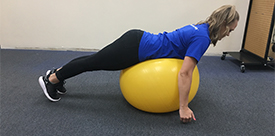
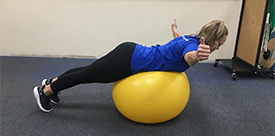
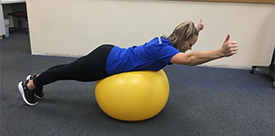
Swimmer’s shoulder can be a frustrating condition that limits participation in valued sport and recreational activities. Incorporate the tips above to help prevent this injury, and make sure to schedule a free assessment with an Athletico expert if you are worried you are developing this injury.
The Athletico blog is an educational resource written by Athletico employees. Athletico bloggers are licensed professionals who abide by the code of ethics outlined by their respective professional associations. The content published in blog posts represents the opinion of the individual author based on their expertise and experience. The content provided in this blog is for informational purposes only, does not constitute medical advice and should not be relied on for making personal health decisions.
Resources:
1. Dodson, Christopher C. “Four Hidden Common Swimming Injuries and Their Prevention.” Rothman Orthopaedic Institute, 9 Nov. 2017, rothmanortho.com/stories/news-and-blog/4-hidden-common-swimming-injuries-and-their-prevention_2480.
2. Tate, A., Harrington, S., Buness, M., Murray, S., Trout, C., & Meisel, C. (2015). Investigation of in-water and dry-land training programs for competitive swimmers in the united states. Journal of Sport Rehabilitation, 24(4), 353-362.
3. Tate, A., Turner, G. N., Knab, S. E., Jorgensen, C., Strittmatter, A., & Michener, L. A. (2012). Risk factors associated with shoulder pain and disability across the lifespan of competitive swimmers. Journal of Athletic Training, 47(2), 149-58.
